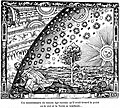Archivi:FlammarionWoodcut.jpg
Aspet

Grandezza de questa pagina de veduda antecipada: 660 × 600 picsel. Alter risoluzzion: 264 × 240 picsel | 528 × 480 picsel | 845 × 768 picsel | 1 127 × 1 024 picsel | 2 254 × 2 048 picsel | 2 934 × 2 666 picsel.
Fail orginal (2 934 × 2 666 picsel, dimension : 9 MByte, sort MIME: image/jpeg)
Cronologia de l'archivi
Schiscia in su un grup data/ora per vedè l'archivi com 'a l'è che l'era in quell moment là
| Data/Ora | Miniadura | Grandezza | Utent | Coment | |
|---|---|---|---|---|---|
| corent | 16:58, 3 Lui 2020 |  | 2 934 × 2 666 (9 MByte) | Sette-quattro | High quality scan with the original caption, from http://urn.fi/URN:NBN:fi-fe2020052939747. Image has been deskewed. |
| 09:38, 19 sgiu 2014 |  | 1 157 × 1 046 (703 KByte) | DxhaFFer | There are two black-and-white versions of this image. One is supposed to have the caption underneath the engraving, the other one is supposed to be without it. This is the large version of the image with the caption taken from the page of the version w... | |
| 03:33, 14 Mrz 2006 |  | 1 162 × 973 (295 KByte) | Brian Brondel | higher resolution | |
| 01:20, 9 sgiu 2005 |  | 504 × 455 (118 KByte) | Sparkit | Flammarion Woodcut. See wikipedia:Flammarion Woodcut {{PD-art}} |
Ligámm
A gh'è minga de pagine che doperen quell fail chì.
Utilizazzion global di fail
Anca questi Wiki chì a dopren quell fail chì:
- Doperad in als.wikipedia.org
- Doperad in ar.wikipedia.org
- Doperad in ar.wikiversity.org
- Doperad in ast.wikipedia.org
- Doperad in bg.wikipedia.org
- Doperad in ca.wikipedia.org
- Doperad in de.wikipedia.org
- Metaphysik
- Schamanismus
- Sternenhimmel
- Firmament
- Wikipedia:Wikipedianer/Soundtrack der Wikipedianer
- Portal:Philosophie/Ausgezeichnete Artikel
- Dualismus
- Wikipedia:Auskunft/Archiv/2006/Juni/3
- Portal:Philosophie/Lesenswerte Artikel
- Portal:Philosophie/Lesenswerte Artikel/Disziplinen und Begriffe
- Portal:Philosophie/Artikel der Woche/51
- Wikipedia:Café/Archiv 2010 Q1
- Diskussion:Weltbild
- Religionsanthropologie
- Benutzer:HerbertErwin/Metaphysik
- Benutzer:NeulichBeimOntologen
- Doperad in en.wikipedia.org
- Doperad in en.wikibooks.org
- Doperad in en.wikisource.org
- Doperad in en.wikiversity.org
- Doperad in en.wiktionary.org
- Doperad in es.wikipedia.org
- Doperad in et.wikipedia.org
- Doperad in eu.wikipedia.org
- Doperad in frp.wikipedia.org
- Doperad in fr.wikipedia.org
Varda utilizazzion global de quell fail chì.





